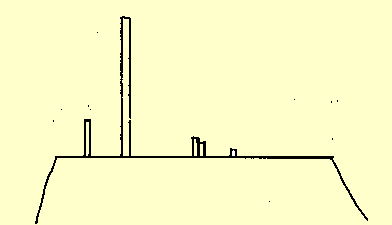Kahili Peak is a unique site, as similar sites are found nowhere else in the Hawaiian Islands. The site is unusual in three main aspects.
These wooden posts ranged from 6-8 inches to 11 inches in diameter and stood from 0.75 foot to 13 feet, 2 inches in height. The site was described by J. J. Jarvis in 1841 and revisited by John F. G. Stokes and Charles Dole in 1915 (BPBM 1931:32,54). The Bishop Museum publication by Bennett on the Archaeology of Kaua'i reported on Stokes's and Dole's description (Bennett 1931:54). Mr. Dole reported that
The function of the site is not very clear from these descriptions. Jarves and Stokes's suggestion that the site was the home of a robber chief or a lookout is improbable because of the harsh climate of the area. The site is often covered with clouds, drenched with rain, and in a very windy, cold place. Could the site be the "funeral pyre" of a chief? Hawaiian custom prohibit cremation except for violators of certain taboos. A large fire at this location would have been a most difficult labor and if it did occur, the evidence of scorching of the posts would have been noted. The use of the site as a funeral platform is a possibility, but nothing in the descriptions would point to this as a function. Such a use of the site would have been recorded in local legends. One thing is sure: that the site was of importance and must have been "financed" by a person of high status. The labor required to cut the kauila logs, to transport them up the steep slope to the site, and finally to place them into holes cut into the bedrock was most demanding. Previously, the surface of the peak had been leveled and the holes cut to fit the logs. The digging of the holes must have been done at the same time that the logs were transported to the site, as the diameters of the posts differed. I would suggest that this was a shrine of unknown function. Its position and elevation command a clear view of the southern shore of Kaua'i as well as the lands to the east. Its size would limit the number of people on the site and the posts may be an alignment for "astronomical" and ceremonial determination. Unfortunately the diagram drawn by Dole (Bennett 1931:32, Fig.3) does not indicate any compass bearings or anything but gross details. Following are copies of the Dole drawing as they appear in Bennett's book and a schematic view of what it would have looked like. The site needs to be revisited, surveyed and described again.
Kalihi Poles
|
